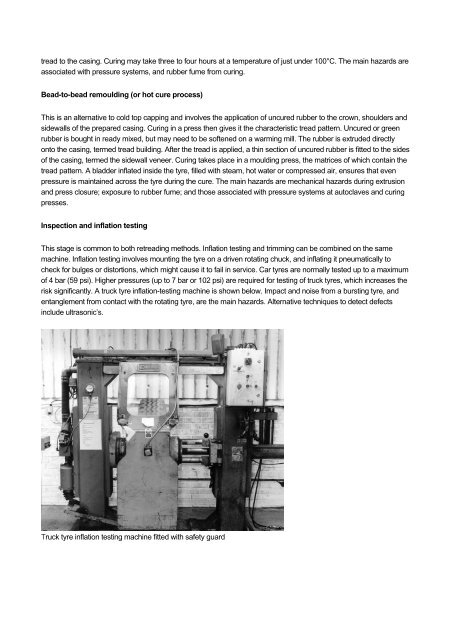Introduction to rubber processing and safety issues - HSE
Introduction to rubber processing and safety issues - HSE
Introduction to rubber processing and safety issues - HSE
Create successful ePaper yourself
Turn your PDF publications into a flip-book with our unique Google optimized e-Paper software.
tread <strong>to</strong> the casing. Curing may take three <strong>to</strong> four hours at a temperature of just under 100°C. The main hazards are<br />
associated with pressure systems, <strong>and</strong> <strong>rubber</strong> fume from curing.<br />
Bead-<strong>to</strong>-bead remoulding (or hot cure process)<br />
This is an alternative <strong>to</strong> cold <strong>to</strong>p capping <strong>and</strong> involves the application of uncured <strong>rubber</strong> <strong>to</strong> the crown, shoulders <strong>and</strong><br />
sidewalls of the prepared casing. Curing in a press then gives it the characteristic tread pattern. Uncured or green<br />
<strong>rubber</strong> is bought in ready mixed, but may need <strong>to</strong> be softened on a warming mill. The <strong>rubber</strong> is extruded directly<br />
on<strong>to</strong> the casing, termed tread building. After the tread is applied, a thin section of uncured <strong>rubber</strong> is fitted <strong>to</strong> the sides<br />
of the casing, termed the sidewall veneer. Curing takes place in a moulding press, the matrices of which contain the<br />
tread pattern. A bladder inflated inside the tyre, filled with steam, hot water or compressed air, ensures that even<br />
pressure is maintained across the tyre during the cure. The main hazards are mechanical hazards during extrusion<br />
<strong>and</strong> press closure; exposure <strong>to</strong> <strong>rubber</strong> fume; <strong>and</strong> those associated with pressure systems at au<strong>to</strong>claves <strong>and</strong> curing<br />
presses.<br />
Inspection <strong>and</strong> inflation testing<br />
This stage is common <strong>to</strong> both retreading methods. Inflation testing <strong>and</strong> trimming can be combined on the same<br />
machine. Inflation testing involves mounting the tyre on a driven rotating chuck, <strong>and</strong> inflating it pneumatically <strong>to</strong><br />
check for bulges or dis<strong>to</strong>rtions, which might cause it <strong>to</strong> fail in service. Car tyres are normally tested up <strong>to</strong> a maximum<br />
of 4 bar (59 psi). Higher pressures (up <strong>to</strong> 7 bar or 102 psi) are required for testing of truck tyres, which increases the<br />
risk significantly. A truck tyre inflation-testing machine is shown below. Impact <strong>and</strong> noise from a bursting tyre, <strong>and</strong><br />
entanglement from contact with the rotating tyre, are the main hazards. Alternative techniques <strong>to</strong> detect defects<br />
include ultrasonic’s.<br />
Truck tyre inflation testing machine fitted with <strong>safety</strong> guard
















